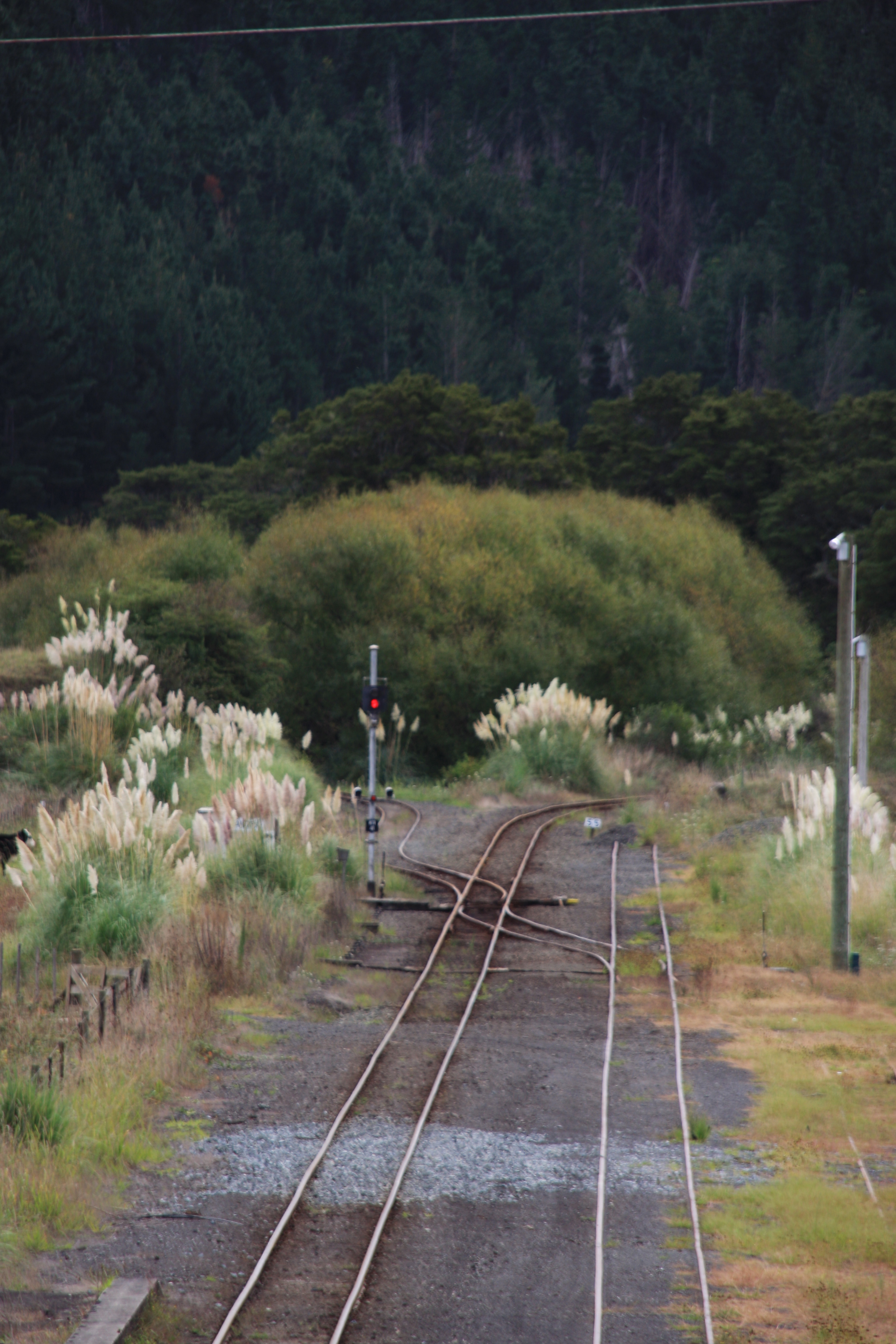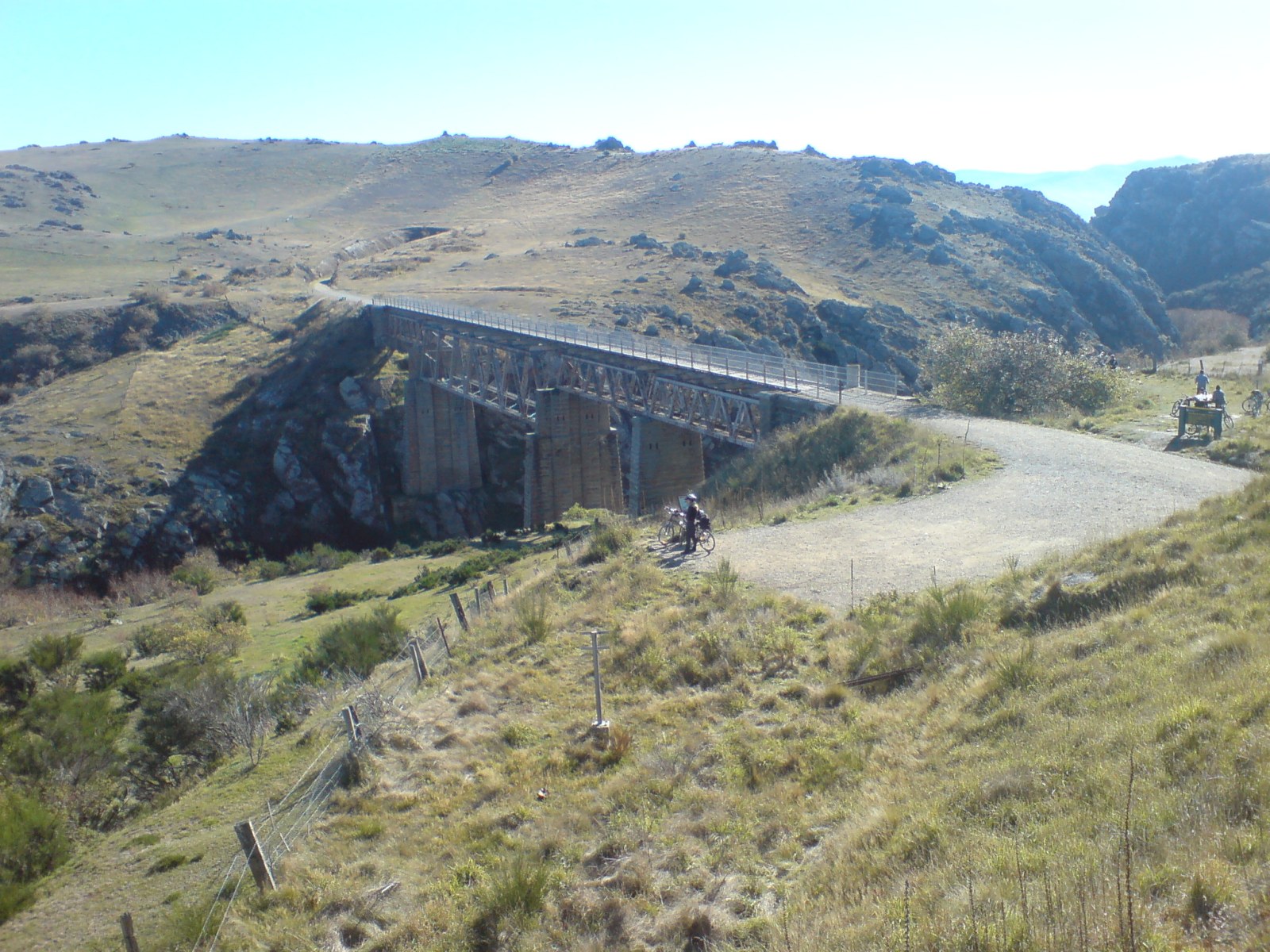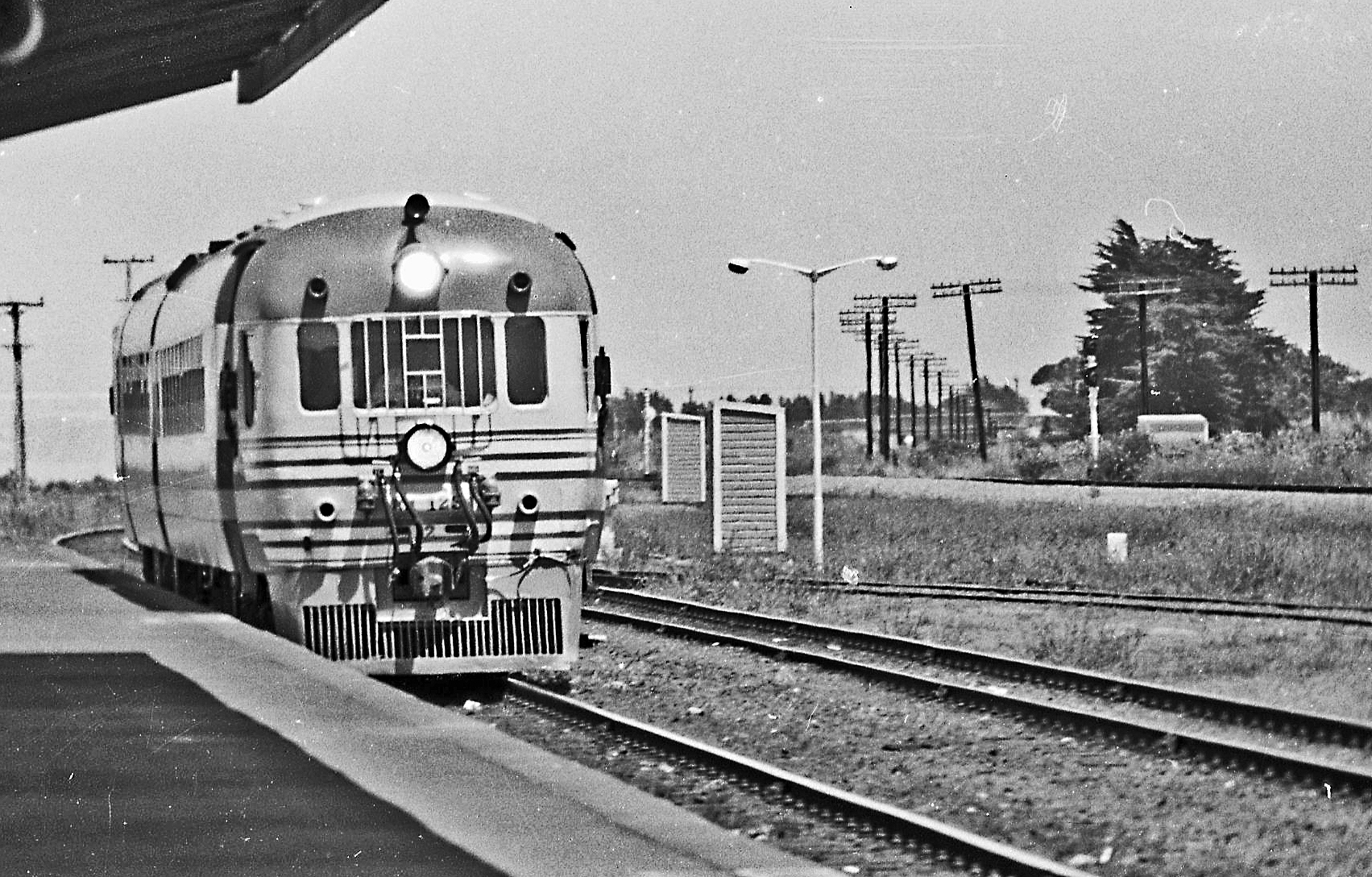|
Okaihau Branch
The Okaihau Branch, sometimes known as the Kaikohe Branch and rarely the Rangiahua Branch, was a branch line railway that joined the North Auckland Line of the national rail network of New Zealand at Otiria. It was the most northerly line in New Zealand and was intended to run all the way to Kaitaia. It opened to Ōkaihau in 1923 and closed in 1987. Construction Proposals for a railway line to Kaitaia and the Far North existed as early as the 1870s, but it was not until 1909 that preliminary surveys were conducted. After the North Auckland Line was linked to and extended over the Opua Branch in 1911, construction progressed in earnest from Otiria towards Kaikohe: initial work had been undertaken in 1910. On 1 May 1914, this section opened. A small amount of further construction took place over the next two years, but World War I meant that no work took place between 1916 and 1919. The resumption of work led to the completion of the line to Ōkaihau on 29 October 1923. ... [...More Info...] [...Related Items...] OR: [Wikipedia] [Google] [Baidu] |
Dargaville Branch
The Dargaville Branch is a branch line railway that leaves the North Auckland Line not far south of Whangarei and runs westward to Dargaville. Construction of this relatively short line took approximately two decades, and when it was completed, it linked the now closed Donnellys Crossing Section with the national rail network. The branch has been closed to all traffic since 2014 and is currently used by a tourist railcart operation. Construction The Dargaville Branch was built relatively late in comparison to most railway lines in New Zealand. Construction from Waiotira on the North Auckland Line commenced in 1922. Dargaville, however, was not reached for another eighteen years. The first twenty-two kilometres through unstable country took six years to build, with the line not opened to Kirikopuni until 15 May 1928. In January 1931, the line was open to Tangowahine, sixteen kilometres from Dargaville, but construction ceased for five years due to the Great Depression. ... [...More Info...] [...Related Items...] OR: [Wikipedia] [Google] [Baidu] |
Otiria Junction Showing Railway Yards, The Railway Station, And Several Trains ATLIB 338372
Otiria is a rural locality in the Northland Region of New Zealand's North Island. It neighbours Moerewa to the east, with the nearest major town, Kawakawa a few kilometres further eastwards. Other nearby localities include Pokapu to the south, Orauta to the west, and Hupara to the north. The New Zealand Ministry for Culture and Heritage gives a translation of "place of planting" for ''Ōtiria''. Education Otiria used to have a primary school. It was closed in 2005 and students were transferred to Moerewa School. Transportation Otiria is situated just off State Highway 1. Otiria is the northernmost operational point of the national railway network. It is the terminus of the North Auckland Line, although a disused siding extends into Moerewa. Otiria railway station (closed in 1993) was a railway junction until the mid-1980s. The Opua Branch section of the North Auckland Line ran northeast to Kawakawa and Opua, while the Okaihau Branch ran northwest to Kaikohe and � ... [...More Info...] [...Related Items...] OR: [Wikipedia] [Google] [Baidu] |
World War II
World War II or the Second World War, often abbreviated as WWII or WW2, was a world war that lasted from 1939 to 1945. It involved the World War II by country, vast majority of the world's countries—including all of the great powers—forming two opposing military alliances: the Allies of World War II, Allies and the Axis powers. World War II was a total war that directly involved more than 100 million Military personnel, personnel from more than 30 countries. The major participants in the war threw their entire economic, industrial, and scientific capabilities behind the war effort, blurring the distinction between civilian and military resources. Air warfare of World War II, Aircraft played a major role in the conflict, enabling the strategic bombing of population centres and deploying the Atomic bombings of Hiroshima and Nagasaki, only two nuclear weapons ever used in war. World War II was by far the List of wars by death toll, deadliest conflict in hu ... [...More Info...] [...Related Items...] OR: [Wikipedia] [Google] [Baidu] |
South Island
The South Island, also officially named , is the larger of the two major islands of New Zealand in surface area, the other being the smaller but more populous North Island. It is bordered to the north by Cook Strait, to the west by the Tasman Sea, and to the south and east by the Pacific Ocean. The South Island covers , making it the world's 12th-largest island. At low altitude, it has an oceanic climate. The South Island is shaped by the Southern Alps which run along it from north to south. They include New Zealand's highest peak, Aoraki / Mount Cook at . The high Kaikōura Ranges lie to the northeast. The east side of the island is home to the Canterbury Plains while the West Coast is famous for its rough coastlines such as Fiordland, a very high proportion of native bush and national parks, and the Fox and Franz Josef Glaciers. The main centres are Christchurch and Dunedin. The economy relies on agriculture and fishing, tourism, and general manufacturing and serv ... [...More Info...] [...Related Items...] OR: [Wikipedia] [Google] [Baidu] |
Little River Rail Trail
The Little River Rail Trail is a cycling and walking track on Banks Peninsula in the Canterbury region of New Zealand's South Island. Location The rail trail utilises the formation of the Little River Branch railway, which ran from a junction with the Southbridge Branch from Hornby via Lincoln to Little River. The railway closed on 30 June 1962 and the formation had remained largely undisturbed until the early 2000s, when a trust was formed to revitalise it for public use. Rail trail history On 28 May 2006 the first section of the rail trail was opened, between Motukarara and Catons Bay Reserve. It has since been extended, first to the Little River hotel, and then to Wairewa Pa Road, some 500 m short of the restored Little River station, which has preserved ex- New Zealand Railways freight wagons and a craft centre. The second section between Prebbleton and Lincoln (7 km) opened on 30 November 2006. This section is an offroad track adjacent to the old railway l ... [...More Info...] [...Related Items...] OR: [Wikipedia] [Google] [Baidu] |
Otago Central Rail Trail
The Otago Central Rail Trail is a 150-kilometre walking, cycling and horse riding track in the South Island of New Zealand. A pioneering project for New Zealand, the successful rail trail joined the New Zealand Cycle Trail umbrella organisation in 2012, having been one of the inspirations for it. The trail runs in an arc between Middlemarch and Clyde, along the route of the former Otago Central Railway. The trail has become a popular tourist attraction, with 10,000–12,000 users per year as a conservative estimate, and yearly (and ongoing) user increases for 6 out of the last 7 years (as of 2011). The trail is also accepted as being, by a large margin, the biggest non-farming economic factor in the Maniototo- Alexandra area. History The original railway line was completed at the turn of the 20th century, and provided a link between Central Otago and Dunedin until closure in 1990. The first 64 km from the junction with the Main South Line in Wingatui remain operational; th ... [...More Info...] [...Related Items...] OR: [Wikipedia] [Google] [Baidu] |
New Zealand State Highway 1
State Highway 1 (SH 1) is the longest and most significant road in the New Zealand road network, running the length of both main islands. It appears on road maps as SH 1 and on road signs as a white number 1 on a red shield, but it has the official designations SH 1N in the North Island, SH 1S in the South Island. SH 1 is long, in the North Island and in the South Island. Since 2010 new roads have reduced the length from . For the majority of its length it is a two-lane single carriageway, with at-grade intersections and property accesses, in both rural and urban areas. These sections have some passing lanes. Around of SH 1 is of motorway or expressway standard : in the North Island and in the South Island. Route North Island (SH 1N) SH 1 starts at Cape Reinga, at the northwestern tip of the Aupouri Peninsula, and since April 2010 has been sealed (mainly with either chipseal or asphalt) for its entire length. From Waitiki Landing south of Cape Reinga, SH 1 t ... [...More Info...] [...Related Items...] OR: [Wikipedia] [Google] [Baidu] |
New Zealand Railways Corporation
New Zealand Railways Corporation (NZRC) is the state-owned enterprise that owns the land beneath KiwiRail's railway network on behalf of the Crown. The Corporation has existed under a number of guises since 1982, when the old New Zealand Railways Department was corporatised followed by deregulation of the land transport sector. In 1986, the Corporation became a State-owned enterprise, required to make a profit. Huge job losses and cutbacks ensued, and the rail network, rail operations and ferry service of the Corporation were transferred to New Zealand Rail Limited in 1990. The Corporation retained ownership of the land beneath the railway network, and charged a nominal rental to New Zealand Rail, which was privatised in 1993, and renamed Tranz Rail in 1995. In 2004, following a deal with Tranz Rail's new owners Toll NZ, the Corporation took over responsibility for maintaining and upgrading the rail network once more, trading under the name ONTRACK. Negotiations with Toll ove ... [...More Info...] [...Related Items...] OR: [Wikipedia] [Google] [Baidu] |
NZR RM Class (88 Seater)
The NZR RM class 88-seaters were a class of railcar used in New Zealand. New Zealand Government Railways (NZR) classified them as RM (Rail Motor), the notation used for all railcars, numbering the 35 sets from RM100 to RM134. They were the most numerous railcars in NZR service. Their purchase and introduction saw the demise of steam-hauled provincial passenger trains and mixed trains, and was part of a deliberate effort to modernise NZR passenger services at a time of increasing competition from private motor vehicles. Being diesel powered and lighter the railcars were less expensive to operate and able to maintain quicker timetables, although became plagued with mechanical and electrical problems, with a number of the class eventually being turned into depowered locomotive-hauled carriages and reclassified as the AC class "Grassgrubs". Background In the early 1950s, NZR was in the process of replacing steam traction with diesel and modernising the railways to cope with vastl ... [...More Info...] [...Related Items...] OR: [Wikipedia] [Google] [Baidu] |
Northland Express
The ''Northland Express'', also known as the ''Opua Express'', was an express passenger train operated by the New Zealand Railways Department between 1925 and 1956. It ran from Auckland via Whangarei to Opua in the Bay of Islands. Operation On 29 November 1925, the North Auckland Line linking Auckland to Whangarei and other parts of Northland was completed. Soon after passenger expresses began to operate, but the twisting, rugged nature of the railway line meant that they did not achieve particularly fast speeds. The ''Northland Express'' was the premier service north of Auckland and it operated thrice weekly in each direction. Mixed trains operated from the termini of the Okaihau and Dargaville branch lines to connect with the ''Express''. By the 1950s, the ''Northland Express'' was able to maintain a schedule of 5 hours and 20 minutes on the section between Auckland and Whangarei and was operated by steam locomotive A steam locomotive is a locomotive that p ... [...More Info...] [...Related Items...] OR: [Wikipedia] [Google] [Baidu] |
Auckland
Auckland (pronounced ) ( mi, Tāmaki Makaurau) is a large metropolitan city in the North Island of New Zealand. The most populous urban area in the country and the fifth largest city in Oceania, Auckland has an urban population of about It is located in the greater Auckland Region—the area governed by Auckland Council—which includes outlying rural areas and the islands of the Hauraki Gulf, and which has a total population of . While Europeans continue to make up the plurality of Auckland's population, the city became multicultural and cosmopolitan in the late-20th century, with Asians accounting for 31% of the city's population in 2018. Auckland has the fourth largest foreign-born population in the world, with 39% of its residents born overseas. With its large population of Pasifika New Zealanders, the city is also home to the biggest ethnic Polynesian population in the world. The Māori-language name for Auckland is ', meaning "Tāmaki desired by many", in ref ... [...More Info...] [...Related Items...] OR: [Wikipedia] [Google] [Baidu] |
Railcar
A railcar (not to be confused with a railway car) is a self-propelled railway vehicle designed to transport passengers. The term "railcar" is usually used in reference to a train consisting of a single coach (carriage, car), with a driver's cab at one or both ends. Some railway companies, such as the Great Western, termed such vehicles " railmotors" (or "rail motors"). Self-propelled passenger vehicles also capable of hauling a train are, in technical rail usage, more usually called " rail motor coaches" or "motor cars" (not to be confused with the motor cars, otherwise known as automobiles, that operate on roads). The term is sometimes also used as an alternative name for the small types of multiple unit which consist of more than one coach. That is the general usage nowadays in Ireland when referring to any diesel multiple unit (DMU), or in some cases electric multiple unit (EMU). In North America the term "railcar" has a much broader sense and can be used (as an ab ... [...More Info...] [...Related Items...] OR: [Wikipedia] [Google] [Baidu] |



.jpg)

_p225_AUCKLAND%2C_NEW_ZEALAND.jpg)
.jpg)